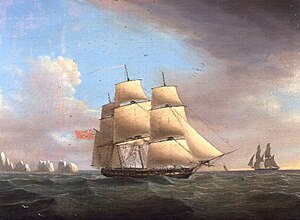Service history
Channel Fleet, 1794–1803
Under the command of Capt. Richard Goodwin Keats the ship formed part of the Channel Squadrons under Sir Edward Pellew and Sir John Borlase Warren where she took part in the capture or destruction of a number of French warships: the frigate La Revolutionnaire was taken on 21 October 1794, while the corvette Le Jean Bart (26) and former British packet L'Expedition (16) were taken by Artois and Galatea on 15 and 16 April 1795. L'Etoile (30), was taken by Galatea, Artois, Anson and Pomone on 20 March 1796. The frigate L'Andromaque (48, but mounting only 40 guns) was driven ashore by Galatea near Arcasson, and there destroyed by the brig Sylph on 23 August 1796.[2]
In 1799, under the command of Capt. George Byng, Galatea was stationed off Southern Ireland. During the winter of 1800 she captured Spanish letter of marque El Pensee, and in April 1801 recaptured the Kenyon, en route from Jamaica to Liverpool with a cargo worth £40,000, which had been taken by the 44-gun Braave.
Galatea cruised in the Atlantic and off the western islands from May to September 1801, and during October and November encountered fifteen severe gales during a 28-day cruise in the Bay of Biscay. On 1 and 2 November she nearly foundered when her mizzen mast and the main and foretop masts carried away. One seaman was lost overboard and several were wounded. Galatea finally limped back to Plymouth under jury rig for a refit before returning to Cork. She was paid off on 28 April 1802.[2]
Recommissioned under Capt. George Wolfe, at the beginning of August 1802 Galatea took discharged Dutch troops from the Isle of Wight to Holland, returning to Plymouth from Den Helder in a gale on 3 September. She then sailed on a cruise against smugglers, which was to be her occupation during the peace of Amiens.[2]
Carribean, 1803–1809
In 1803 under Capt. Henry Heathcote, she fitted out at Portsmouth, and on 8 July sailed to take up position as guardship off The Needles. In February 1804 she escorted a fleet of merchantmen to the West Indies, and on 14 August made an unsuccessful attempt to cut out the French privateer General Ernouf (formerly the British sloop-of-war Lilly) lying at the Saintes near Guadeloupe.[2]
In 1805 under Capt. Murray Maxwell at Jamaica. On 18 August 1806 Lieut. M'Culloch, in the ship's barge, pursued a schooner for some miles up a river on the Spanish Main near Porto Cavallo before capturing her. She proved to be a fine Spanish privateer with three long 6 and 4-pounders. The lieutenant blew her up and brought away the prisoners.[2]
Off Guadeloupe on the morning of 12 November 1806, under Capt. George Sayer, Galatea gave chase to the schooner Reunion (10) bound for Martinique from La Guaira with cargo and dispatches for the French General from the Spanish government at Caracas.[2]
On the morning of 21 January 1807 Galatea was off the coast of Venezuela when she sighted a sail steering for Guaira. They closed, identified her as a man-of-war, and forced her to change course for Barcelona, some 160 miles to the east. By noon Galatea was becalmed while the enemy had the benefit of a slight breeze and two hours later her top-gallant sails were scarcely above the horizon. Galatea's boats were launched under first Lieut. William Coombe, with Lieuts. Harry Walker and Robert Gibson, Master's Mates John Green and Barry Sarsfield, 50 seamen and 20 marines, and after rowing about 35 miles in eight hours they caught up with her. Twice they tried to board on both quarters, but were forced to retreat by the fire from her guns, so they fell back and poured musket and small arms fire through the stern and quarter ports which cleared the deck of many of the enemy, including the captain and most of his officers. The third attack was successful and they soon found themselves in possession of the Lynx, armed with fourteen 24-pounder carronades and two long 9-pounder guns. She was taken into the Royal Navy as Heureux under the command of Lieut. Coombe.[2]
Fate
Galatea returned to England in the spring of 1809 and her condition was so bad that she was soon broken up at Woolwich.[2]
